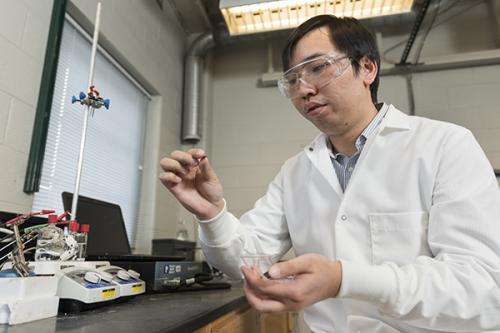Silver electrocatalysts may help enable long-term space travel

Despite continuous advances, major obstacles remain before manned missions can set off for destinations like Mars. A primary concern is how people will breathe.
Long-duration space flights would travel far away from Earth and take years. Oxygen tanks can't be shuttled out to resupply the astronauts, so the air must be recycled. Yet state-of-the-art systems are only about 50 percent efficient at recovering used oxygen from carbon dioxide.
NASA is funding several projects attempting to solve this problem, one of which involves a University of Delaware engineer and came about through a serendipitous connection.
A scientist at NASA's Glenn Research Center contacted Feng Jiao, assistant professor in UD's Department of Chemical and Biomolecular Engineering, after he and his colleagues published a paper in Nature Communications in January 2014.
Jiao's team had created a silver electrocatalyst that, due to its carefully designed nanoscale structure, could convert carbon dioxide to carbon monoxide with 92 percent efficiency—freeing oxygen in the process.
The catalyst itself is a silver coating on the surface of an electrode that increases the efficiency of the CO2-CO reaction by assisting with the transfer of electrons.
"The catalyst performance is definitely among the best," Jiao says. "It's very selective, very efficient."
Carbon monoxide (CO) has many industrial applications, and the initial idea was to convert abundant CO2 to useful CO, with the oxygen as an incidental byproduct.
Now that byproduct is what they're focused on.
Jiao and the NASA scientist, Ken Burke, are co-principal investigators on a $750,000 NASA-funded grant, one of four teams trying to create the most efficient oxygen recycling system possible.
Burke's lab was working on a technology to convert two molecules of carbon monoxide to one molecule of carbon dioxide and one molecule of carbon. If they can combine their systems, says Jiao, "then eventually we can completely split CO2 to one molecule of carbon and one molecule of oxygen."
With such a system, "in principle, we can recover 100 percent of the oxygen from CO2. NASA is very interested in developing this kind of technology for deep space exploration," Jiao says.
The first challenge for the UD team is to convert the University laboratory's electrocatalysis device. The system currently processes its ingredients in batches, but for this purpose it must run continuously.
They then have to integrate their part of the work with what Burke's lab in Ohio has created.
If their system is one of the two chosen by NASA for further exploration, they will be granted $2 million to adapt the system for large-scale use.
"Right now, these kinds of lab-scale systems are not even sufficient to support one crew member in space travel," says Jiao. "In Phase II we want to develop a system which can support four people on board."
They will also ensure that the system is compatible with a zero-gravity environment and stable enough for operation over a period of months. Eventually, the winning system will go up for in-flight testing.
This is the first time Jiao has worked with NASA, an exciting prospect for him. "My students also got very excited," he says. "They're actually very eager to start this project and see how far we can push this technology."
More information: "A selective and efficient electrocatalyst for carbon dioxide reduction." Nature Communications 5, Article number: 3242 DOI: 10.1038/ncomms4242
Journal information: Nature Communications
Provided by University of Delaware




















